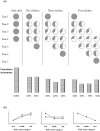Middleborns disadvantaged? Testing birth-order effects on fitness in pre-industrial Finns
- PMID: 19492096
- PMCID: PMC2683935
- DOI: 10.1371/journal.pone.0005680
Middleborns disadvantaged? Testing birth-order effects on fitness in pre-industrial Finns
Abstract
Parental investment is a limited resource for which offspring compete in order to increase their own survival and reproductive success. However, parents might be selected to influence the outcome of sibling competition through differential investment. While evidence for this is widespread in egg-laying species, whether or not this may also be the case in viviparous species is more difficult to determine. We use pre-industrial Finns as our model system and an equal investment model as our null hypothesis, which predicts that (all else being equal) middleborns should be disadvantaged through competition. We found no overall evidence to suggest that middleborns in a family are disadvantaged in terms of their survival, age at first reproduction or lifetime reproductive success. However, when considering birth-order only among same-sexed siblings, first-, middle- and lastborn sons significantly differed in the number of offspring they were able to rear to adulthood, although there was no similar effect among females. Middleborn sons appeared to produce significantly less offspring than first- or lastborn sons, but they did not significantly differ from lastborn sons in the number of offspring reared to adulthood. Our results thus show that taking sex differences into account is important when modelling birth-order effects. We found clear evidence of firstborn sons being advantaged over other sons in the family, and over firstborn daughters. Therefore, our results suggest that parents invest differentially in their offspring in order to both preferentially favour particular offspring or reduce offspring inequalities arising from sibling competition.
Conflict of interest statement
Figures




References
-
- Pavard S, Gagnon A, Desjardins B, Heyer E. Mother's death and child survival: the case of early Quebec. Journal of Biosocial Science. 2005;37:209–227. - PubMed
-
- Voland E. Differential Infant and Child Mortality in Evolutionary Perspective: Data from Late 17th to 19th Century Ostfriesland (Germany). In: Betzig LL, Borgerhoff Mulder M, Turke PW, editors. Human reproductive: A Darwinian Perspective. Cambridge: Cambridge University Press; 1987. pp. 253–261.
-
- Lindström J. Early development and fitness in birds and mammals. Trends in Ecology & Evolution. 1999;14:343–348. - PubMed
-
- Metcalfe NB, Monaghan P. Compensation for a bad start: grow now, pay later? Trends in Ecology & Evolution. 2001;16:254–260. - PubMed
-
- Lummaa V. Early developmental conditions and reproductive success in humans: downstream effects of prenatal famine, birthweight, and timing of birth. American Journal of Human Biology. 2003;15:370–379. - PubMed

